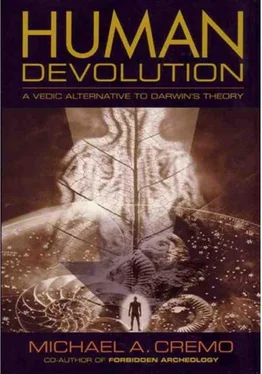Michael Cremo - Human Devolution - A Vedic Alternative To Darwin's Theory
Здесь есть возможность читать онлайн «Michael Cremo - Human Devolution - A Vedic Alternative To Darwin's Theory» весь текст электронной книги совершенно бесплатно (целиком полную версию без сокращений). В некоторых случаях можно слушать аудио, скачать через торрент в формате fb2 и присутствует краткое содержание. Год выпуска: 2003, ISBN: 2003, Издательство: Torchlight Publishing, Жанр: Старинная литература, на английском языке. Описание произведения, (предисловие) а так же отзывы посетителей доступны на портале библиотеки ЛибКат.
- Название:Human Devolution: A Vedic Alternative To Darwin's Theory
- Автор:
- Издательство:Torchlight Publishing
- Жанр:
- Год:2003
- ISBN:9780892133345
- Рейтинг книги:4 / 5. Голосов: 1
-
Избранное:Добавить в избранное
- Отзывы:
-
Ваша оценка:
- 80
- 1
- 2
- 3
- 4
- 5
Human Devolution: A Vedic Alternative To Darwin's Theory: краткое содержание, описание и аннотация
Предлагаем к чтению аннотацию, описание, краткое содержание или предисловие (зависит от того, что написал сам автор книги «Human Devolution: A Vedic Alternative To Darwin's Theory»). Если вы не нашли необходимую информацию о книге — напишите в комментариях, мы постараемся отыскать её.
Human Devolution: A Vedic Alternative To Darwin's Theory — читать онлайн бесплатно полную книгу (весь текст) целиком
Ниже представлен текст книги, разбитый по страницам. Система сохранения места последней прочитанной страницы, позволяет с удобством читать онлайн бесплатно книгу «Human Devolution: A Vedic Alternative To Darwin's Theory», без необходимости каждый раз заново искать на чём Вы остановились. Поставьте закладку, и сможете в любой момент перейти на страницу, на которой закончили чтение.
Интервал:
Закладка:
1933, p. 55). In connection with the sea there is a master of the sea, a Sea Man, known by the name tol-yz, or tayrnadz. Shternberg (1933, p. 55) says, “The god of the sea, Tayrnadz, lives on the bottom of the Sea of Okhotsk. He is a very old man with a white beard, who lives with his old wife in an underwater yurt. In the yurt there is a huge number of boxes with all kinds of spawn, which he throws by the handful into the sea from time to time. It is he who, at the appointed time, sends the countless detachments of salmon, without which the life of the Gilyak would be impossible; it is he who sends out the kosatki [killer whales] to establish order in the sea and drive all kinds of sea animals toward the Gilyak.” In connection with the earth, there is an Under Earth Man. These deities resemble the Gilyak in their outer appearance, but they are endowed with mystical powers, including the ability to take the forms of the animals, trees, or stones under their control. Sometimes the Gilyak may be seen worshiping these forms, but the real deities are the masters (Shternberg 1933, p. 54).
The Gilyak regard the bear as a particularly sacred animal who carries out the divine will. For example, the bear punishes evildoers during their lifetimes. The soul of a Gilyak who is killed by a bear is said to enter the body of a bear. Schrenck (1881–1895, p. 749) says, “The belief in the transmigration of souls with reference to the bear may be the basis of a number of pictorial representations among the Gilyaks—amulets or small idol-images that are worn around the neck in case of sickness. Among them one finds double figures of a human being and bear. This is ordinarily a small piece of wood which at one end branches out into two parts, one representing a human head, the other a bear’s head.”
In addition to the deities of the more important forces and creatures of nature, there are also many less important ones who watch over every aspect of Gilyak life. There are also categories of deities who are quite distant from the Gilyak, such as the sun, the moon, and “the heavenly people,” called tly-nivukh. Shternberg (1933, p. 55) says, “Out of mischievousness a heavenly man will lower a fishing rod with hooks to the earth in order to catch some Gilyak. This does not always work, however. For example, the young Gilyak, Il’k, from the village of Arkovo told me that tly-nivukh once caught his father with a golden hook, and he just saved himself by grabbing a tree, thus getting away with only a scare and a torn coat.” Another of Shternberg’s informants told him (1933, p. 363), “A certain man once met the master of the sky. He was riding on a sled pulled by wolves, but, upon encountering the Gilyak, the wolves turned upward and disappeared into the sky with their rider.”
The Gilyak also worship clan gods. The clan gods are Gilyaks who after death have entered into the association of one of the nature gods. Shternberg (1933, p. 58) says, “If, while hunting, a Gilyak was killed by a bear, if he fell prey to the waves on the water, if he was murdered or burned to death through his own carelessness, if, according to the shaman’s explanation, a woman died from a bear’s love for her, etc.—all such persons do not travel to the ordinary kingdom of the shades, but go over into the clan of the gods—masters who took a liking to them, of the mountain, water, fire, etc., and then become the smallest ‘masters’ and protect their clansmen. In this way the clan pal’-nivukh’i— forest people, tol’-nivukh’i— sea people, etc. took form. It is to these gods-clansmen that the entire clan offers sacrifices.” These departed Gilyak, having become clan gods, appear before the living in the form of certain animals. The forest clan gods appear as bears, the sea clan gods as beluga whales or killer whales (Shternberg 1933, p. 58). The clan gods act for the benefit of their living descendants. The clan gods remain in their positions for up to two generations (Shternberg 1933, p. 89). Gilyak who become clan gods are remembered through special shrines. For example, if a Gilyak drowns and becomes a clan god associated with the master of the sea, the Gilyak put at his place of cremation a boat, with all equipment for sea or river travel.
The Gilyak gods are sometimes worshiped in the form of idols. Sometimes the Gilyak wear small idols on strings around their necks. These are called sawa (Schrenck 1881–1895, p. 745). The person wearing the idol gives it a little of the food he eats by touching it to the idol’s mouth. The idols are not simply representations. The Gilyak believe that spirits reside in them. The resident spirit is known by the name kobold. Schrenck (1881–1895, p. 240) says, “If an idol is ‘heavy’ it means that its inhabitant, the kobold , is at home, but when it gets ‘lighter’ than usual, the spirit is roaming about somewhere.” The Gilyak consider fire, and the fire deity, to be the medium by which humans can communicate with the other more powerful deities. For example, the hunter offers sacrifices into fire for the Lord of the Forest, so that he will be successful in killing animals (Coxwell 1925, p. 118).
Some spirits are actively hostile to the Gilyak. These are called melk, which means, roughly, devil. Like the other deities, they are connected with elements and features of nature (Coxwell 1925, p. 120). So there are sea devils, mountain devils, forest devils, etc. The sea devils ride in boats, and if they see the Gilyak coming in boats to hunt seals, they shout, “What are you doing here?” One of the evil spirits is called Ge-nivukh. He lives in an earthen mound near Tekhrvo. He comes to the home of a Gilyak, and through the window he asks for something, gesturing with two fingers extended. If he gets something, he departs. Sometimes the Gilyak give him a coal. Not quite understanding, Ge-nivukh begins tossing the hot coal from hand to hand, saying, “It is hot, if you do not have (anything), do not give!” But Ge-nivukh is not always so easily put off. He is known to kidnap people, especially children. For a person faced with kidnaping by Ge-nivukh there is something that can be done to prevent it: “the only way is to inflict a wound upon oneself, for Ge-nivukh is afraid of blood” (Shternberg 1933, p. 321). The Gilyak believe that except for the attacks of the evil spirits, they would live forever in their earthly bodies. Sickness is interpreted as the attack of evil spirits who have invaded the body. Shternberg (1933, p. 73) says, “Just as he, the Gilyak, lies in wait for a beast and tries in every way to kill him, so an evil spirit lies in wait for the Gilyak himself at every step in order to devour him.”
The supreme being, creator, and moral authority is called Kiskh. According to the Gilyak, a sick person has offended Kiskh. This offense leaves the person subject to the influence of evil spirits. An offering is made to the evil spirit, to induce it to leave the person. The Gilyak don’t make offerings to Kiskh for the relief of disease or any other purpose. The Gilyak worshiper’s relationship with Kiskh appeared mysterious to observers such as Charles H. Hawes, who wrote (1903, p. 162): “So vague is his notion of him that he can only be said to exist in his mind as a nebulous conception.” Schrenck (1881–1895, p. 740) says: “Among the Gilyak there is an obscure and hazy conception of ‘God,’ of a supreme being, who has the attribute of the ‘Good One’ in full measure and without any admixture of evil and who is revered by human beings. But this conception is a wholly abstract, completely empty one and does not at all fit into the life, into the customs and practices of the Gilyaks; there is nothing concrete about it for them, and therefore they only know the word ‘pray,’ but not the act itself. Also, they know nothing about ‘God,’ in view of the complete emptiness of the concept, except that he is kíngulatsch, the
Читать дальшеИнтервал:
Закладка:
Похожие книги на «Human Devolution: A Vedic Alternative To Darwin's Theory»
Представляем Вашему вниманию похожие книги на «Human Devolution: A Vedic Alternative To Darwin's Theory» списком для выбора. Мы отобрали схожую по названию и смыслу литературу в надежде предоставить читателям больше вариантов отыскать новые, интересные, ещё непрочитанные произведения.
Обсуждение, отзывы о книге «Human Devolution: A Vedic Alternative To Darwin's Theory» и просто собственные мнения читателей. Оставьте ваши комментарии, напишите, что Вы думаете о произведении, его смысле или главных героях. Укажите что конкретно понравилось, а что нет, и почему Вы так считаете.












